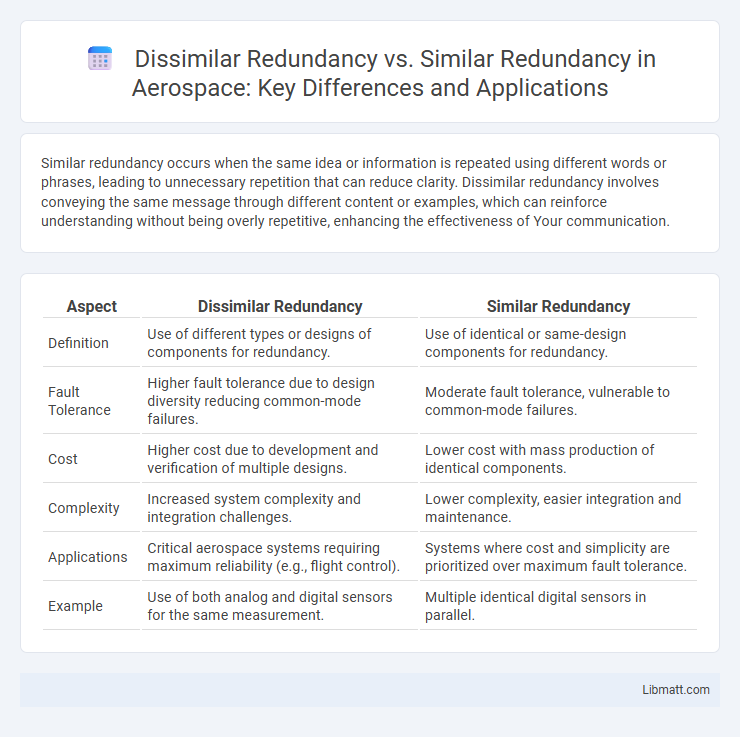Similar redundancy occurs when the same idea or information is repeated using different words or phrases, leading to unnecessary repetition that can reduce clarity. Dissimilar redundancy involves conveying the same message through different content or examples, which can reinforce understanding without being overly repetitive, enhancing the effectiveness of Your communication.
Table of Comparison
| Aspect | Dissimilar Redundancy | Similar Redundancy |
|---|---|---|
| Definition | Use of different types or designs of components for redundancy. | Use of identical or same-design components for redundancy. |
| Fault Tolerance | Higher fault tolerance due to design diversity reducing common-mode failures. | Moderate fault tolerance, vulnerable to common-mode failures. |
| Cost | Higher cost due to development and verification of multiple designs. | Lower cost with mass production of identical components. |
| Complexity | Increased system complexity and integration challenges. | Lower complexity, easier integration and maintenance. |
| Applications | Critical aerospace systems requiring maximum reliability (e.g., flight control). | Systems where cost and simplicity are prioritized over maximum fault tolerance. |
| Example | Use of both analog and digital sensors for the same measurement. | Multiple identical digital sensors in parallel. |
Introduction to Redundancy in Systems
Redundancy in systems ensures reliability by duplicating critical components or functions, classified as similar redundancy or dissimilar redundancy. Similar redundancy involves identical elements performing the same task to provide backup, whereas dissimilar redundancy uses different methods or components to achieve fault tolerance, minimizing common-mode failures. Understanding these types helps you design robust systems that maintain operational integrity under various failure conditions.
Defining Dissimilar Redundancy
Dissimilar redundancy involves using different types of components or systems to perform the same function, enhancing system reliability by mitigating common-mode failures. Unlike similar redundancy, which duplicates identical components, dissimilar redundancy leverages diverse technologies or designs to reduce the risk of simultaneous faults. This approach is critical in safety-critical industries like aerospace and nuclear power, where failure tolerance is paramount.
Defining Similar Redundancy
Similar redundancy refers to the repetition of information that is nearly identical in meaning or structure, often occurring within the same document or dataset. This type of redundancy can obscure clarity, inflate content length, and reduce overall data efficiency. Understanding similar redundancy helps you improve data quality by identifying and eliminating repetitive, overlapping information.
Key Differences Between Dissimilar and Similar Redundancy
Dissimilar redundancy employs different components or systems to perform the same function, enhancing fault tolerance by reducing the risk of simultaneous failure due to identical defects. Similar redundancy uses duplicate components that are identical in design and function, providing straightforward backup but increasing vulnerability to common-mode failures. Your choice between these redundancy types directly impacts system reliability and risk management strategies.
Advantages of Dissimilar Redundancy
Dissimilar redundancy offers enhanced fault tolerance by using diverse components or software to perform the same function, significantly reducing the risk of common-mode failures. This approach improves system reliability and safety in critical applications such as aerospace, nuclear power, and medical devices by ensuring that an error in one module is unlikely to affect the others. You benefit from higher assurance that your system continues to operate correctly even if one element fails due to design or implementation flaws.
Advantages of Similar Redundancy
Similar redundancy provides enhanced data reliability by storing identical copies across multiple systems, ensuring seamless failover and quick recovery in case of hardware failure. It simplifies data management and backup processes while minimizing data loss risks, resulting in improved system availability. The uniformity in data copies also facilitates consistent performance monitoring and error detection.
Common Applications of Dissimilar Redundancy
Dissimilar redundancy is commonly used in aerospace systems, nuclear power plants, and safety-critical medical devices where diverse hardware and software perform identical functions independently to prevent common-mode failures. Unlike similar redundancy, which relies on identical components, dissimilar redundancy enhances fault tolerance by reducing the risk of simultaneous failures due to design or manufacturing flaws. Your system's reliability significantly improves by incorporating dissimilar redundancy in environments demanding the highest safety and operational integrity.
Common Applications of Similar Redundancy
Similar redundancy is frequently used in data storage and backup systems, where identical copies of information are maintained to prevent data loss and ensure reliability. In cloud computing, similar redundancy supports seamless disaster recovery by replicating data across multiple servers or locations. Your critical systems benefit from similar redundancy by minimizing downtime and maintaining continuous access through fault-tolerant designs.
Challenges and Limitations of Both Approaches
Dissimilar redundancy faces challenges in increased complexity and higher costs due to the need for different designs and verification processes, which can introduce unforeseen integration issues. Similar redundancy, while simpler and more cost-effective, may suffer from common mode failures since identical components share the same vulnerabilities, limiting system reliability. Your choice between these redundancy approaches must balance the trade-offs of complexity versus susceptibility to failure in your specific application.
Choosing the Right Redundancy Strategy
Choosing the right redundancy strategy depends on your system's requirements for reliability and cost efficiency. Dissimilar redundancy uses different components to protect against common-mode failures, ensuring higher fault tolerance but often at increased expense. Similar redundancy involves identical components, simplifying maintenance and reducing costs while still providing effective backup for predictable failures.
Dissimilar redundancy vs Similar redundancy Infographic

 libmatt.com
libmatt.com